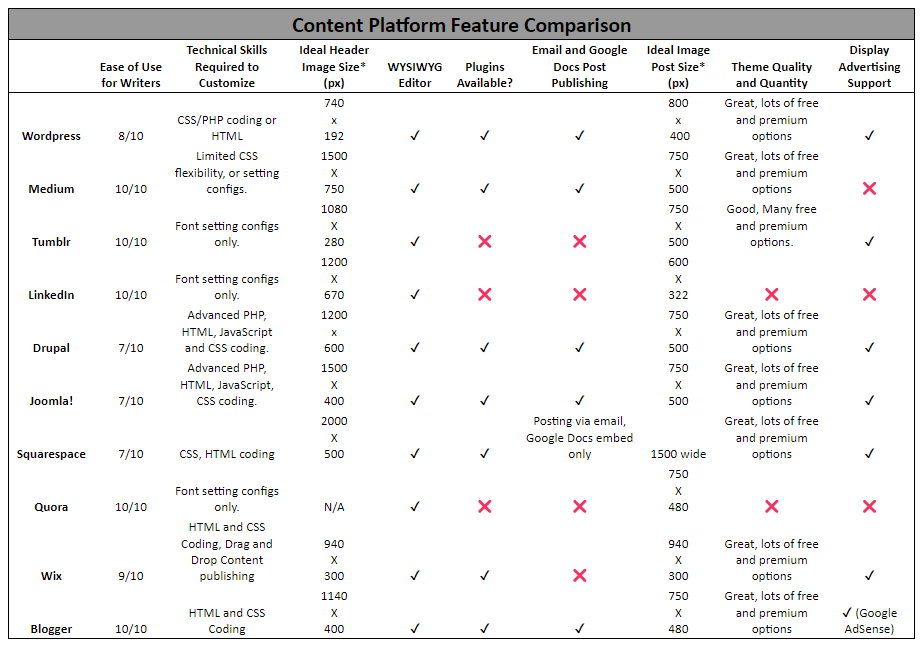In the digital realm, writing skill is a critical factor in building authority, attracting an audience, and convincing them to come back for more. Yet even a superior storyteller will struggle to achieve his or her goals if their content doesn’t meet the information architecture requirements of their blogging platforms.
Maybe you’re an accomplished print journalist, shifting your writing style to online publishing. Or you could be a subject matter expert in a niche like technology, health, fitness, or automotive.
Regardless of your passion, you want your blogs and articles to be:
- Easy to read on any device
- Accentuated by context-sensitive images and graphics
- Discoverable by search engines or on the platform itself
- Easily shared with a broader audience
- Interactive, so writers can spark conversations with their readers
- Similar enough to other engaging content on the platform. So you seem experienced but unique enough that it stands out from other writers clamoring for attention.
This paper will look at the following blogging platforms, in no particular order:
- WordPress.org and WordPress.com
- Medium
- Tumblr
- LinkedIn Pulse
- Wix
- Blogger
- Joomla!
- Drupal
- Quora
- Squarespace
This is by no means an exhaustive list of every blogging platform, yet it covers the leading apps in the space. Where statistics are available, like the number of blogs on the platform are available, you’ll find this information in the chart below.
WordPress.org & WordPress.com
In the world of blogging platforms, WordPress is the 800-pound gorilla. It is estimated that 60 percent of the websites that are built on a content management system are powered by WordPress, representing nearly 30 percent of websites on the internet. Many blogs built on WordPress aren’t even counted in official statistics because they are considered unfinished works in progress or too small.
The popularity of WordPress is in large part due to:
- Ease of use – Blog writers can build a decent site with limited technical expertise
- Extensibility through plug-ins and flexible themes
- The supportive global WordPress community of developers, bloggers, and designers
- SEO-friendly publishing tools like Yoast!
- Availability of affordable hosting plans
- Open source and customizability through CSS (Cascading Style Sheets), PHP, and HTML coding
- Shareable content through social media plugins
- Ease of embedding images, videos, and forms into content
Automattic, the development company behind WordPress, offers a paid, hosted version of WordPress through WordPress.com. They also offer a no-charge, self-hosted edition of the application at WordPress.org to enable writers to download WordPress and contract the hosting service of their choice. Writers can leverage one of the thousands of free or premium themes to quickly build an SEO-friendly website to connect with their target audience and showcase their articles. It was initially designed as a blogging tool but has evolved into a popular, blog-friendly content management system for many popular media websites like the Village Voice, Entertainment Weekly, and TheWaltDisneyCompany.com. Writers can use Google Docs or email to publish to WordPress.
Beginners can access free and affordable WordPress training from WP101.com and the WordPress support forum.
Medium
For bloggers who want to focus on writing content and publishing it easily, Medium offers an excellent experience. Medium was launched by two of the founders of Twitter in 2013 and offers writers a way to be found by a digitally savvy audience who navigate through the platform by categories and tags.
Medium is free for writers to publish articles on the platform. However, it charges its readers $5 per month to read exclusive articles from recognized experts and top writers. Similar to many platforms, Medium started out as a community for writers to share their opinions and expertise. Since then, media organizations and other companies have joined the platform.
A select few writers and brands have custom domains (which were available for a limited time). Writers and publishers who want to monetize their blogs can sign up for the Medium Partner program to publish their blogs as only accessible by paying members. Medium enables readers to share stories with Facebook and Twitter sharing buttons or to show their love for blogs with a “Clap” button.
Tumblr
Tumblr, which launched in 2007, is a popular platform for short blogs, usually enhanced by dynamic content. It’s ideal for casual blogs or for companies with a great deal of visual and audio content to share.
Readers can show their appreciation for a writer’s work by “reblogging” an article, which acts like a retweet on Twitter. This is appropriate because Tumblr is a hybrid of Medium and Twitter. Many millennial and younger social media users traded Facebook for Tumblr as a social media channel due in part to its privacy and messaging features.
Tumblr doesn’t require technical skills to post blogs and supporting images and videos on its platform. Bloggers targeting millennials and Gen-Z’ers who want to share videos and images are the most likely to get the most engagement out of Tumblr.
Bloggers looking to build a business-related audience should add LinkedIn to their list of platforms. Writers who are using one or more of the blogging platforms on this list should still take advantage of LinkedIn’s community of professionals. LinkedIn Pulse offers writers a clean, intuitive writing interface. Bloggers can write in plain text, add images and videos, and tag their articles for discoverability.
Like most of the platforms on this list, writers don’t need any technical design or development skills to create and publish an article to showcase their expertise. The WYSIWYG editor offers simple formatting options and lots of white space for blogging enthusiasts.
LinkedIn provides writers with simple statistics to track the number of people who have viewed their posts, shared them, and where they came from. The LinkedIn search engine helps readers to discover your posts, and the content is exposed to Google indexing and search. It’s also a great way to generate inbound links to another blogging platform.
Blogging on the LinkedIn platform comes with a “baked-in” audience, sources of inspiration for writing ideas, and tools to target and measure your content. It doesn’t have to be a writer’s only blog destination, but it should be on every writer’s list if their content is geared to a B2B audience.
Wix
For writers looking to establish a web presence without investing a great deal of time or money on design or development, Wix is a great platform to get a decent-looking template-driven starter website up and running. Wix offers ease of use for beginners who don’t feel the need to customize their website beyond their template. It enables comments, embedded HTML, and social shares. Savvy writers can format their content and keyword optimize H1s, page titles, and tags for SEO.
Writers looking for a more scalable, dynamic, and extensible blogging platform may find Wix pretty restrictive, though. Wix does make for a good companion platform for writers who also use social platforms like LinkedIn, Medium, or Tumblr as well.
Blogger
While LinkedIn offers writers access to the huge community of its users, Blogger is owned by the world’s most-used search engine. It is also tightly integrated with Google apps like AdWords, AdSense, and Google Analytics. Since Google manages Blogger’s infrastructure, it’s highly secure and reliable.
Beginner bloggers and writers looking for their words and related images/videos to be the star of their website can’t go far wrong with Blogger. The platform was one of the first writer-friendly, easy-to-use platforms that didn’t require advanced design or development skills.
There are a number of templates available for blogger sites, and writers can opt to use a “Blogspot.writername” domain or use their own custom domain. Blogger offers gadgets and plugins for advanced functionality, just as WordPress offers widgets and plugins for code-free customization.
In terms of blog volume, Blogger ranks second as far as the number of blogs built on its platform. Google hasn’t invested much in terms of R&D on the platform over the years, though. So many advanced writers and active bloggers have switched platforms for more flexibility and sophisticated design. Blogger is free, fast to set up, and easy to use. Writers can use Google Docs or email to publish their posts to Blogger.
Squarespace
For writers who prioritize design and sophistication over a free writing platform, Squarespace offers templates that look excellent on any device. Writers who are willing to invest in the platform will be impressed by how plugins consistently work very well, even though there are fewer of them than WordPress. Squarespace is also very easy to use, and bloggers can get a professional-looking website up and running quickly.
Since Squarespace is a subscription-based website and blog-building application, the support and documentation are more advanced and organized than the open-source options described here. Writers looking to build an audience for a book or a portfolio for professional writing services on other sites can easily justify the investment in Squarespace in exchange for the quality user experience that the platform delivers.
Drupal
Technically savvy writers or developers who want to build authority with their own blog will appreciate how customizable Drupal is as a content/blog platform. Drupal is open source and really requires coding experience to create and manage a blog or thriving website. There are hundreds of templates, plugins, and hosting options available for Drupal.
Novices to web publishing and content management should likely give Drupal a pass or be willing to pay/bribe a Drupal-savvy designer/developer to manage their blogging site for them. Articles can be emailed in or published through integration with Google Drive/Docs, but setting up that functionality requires…you guessed it..technical skills. Drupal is a true content management platform, and writers without coding chops should probably look elsewhere.
Joomla!
Similar to Drupal, Joomla is a sophisticated open-source CMS. Writers who work for companies with Joomla sites do have some options for writing blogs without having to learn to code. Joomla Core has evolved, though, to make it easier for writers to create content without writing lines of code.
Blogging tools for Joomla include:
- WordPress for Joomla
- EasyBlog
- Zoo Content Creation Kit
- K2 Content Creation Kit
Though Joomla may not be the first choice for writers as their own blogging platform, it does offer options for content creation that don’t require development.
Quora
Quora is well known as the leading web destination for Q&A on a broad spectrum of topics. Similar to LinkedIn and Medium, Quora has an audience of curious readers and researchers. Writers don’t need any technical skills to publish on Quora. Quora promises bloggers on the platform a lot of visibility (30,000+ views a month), yet those claims are difficult to confirm. As with any blog, reader engagement will depend on the quality of the writing and the writer’s expertise.
Articles written on the Quora platform aren’t searchable by Google or any external search engine. Quora has a large audience of its own and is a powerful search engine in its own right. Writers can build a following by providing insightful answers to questions and by writing quality articles on their blogs. Readers can comment on what they read and click on links to external websites.
Blogs on the Quora platform are all on the Quora domain, such as blogname.quora.com
Summary
If you are an avid writer and have the expertise you want to share – these brief overviews of popular blogging platforms should help you select where you should publish your content. Many writers use more than one of these platforms and link back to their main blog on a platform like WordPress or Squarespace.
According to Buffer, the ideal length of a blog post on any platform is 1600 words or an average reading time of seven minutes. Images enable writers to shorten that number. Longer blog posts tend to be shared more often on social media, while shorter posts tend to encourage more reader comments.
Articles can be published on multiple platforms, though writers looking to build a following and make their content discoverable should do their research on canonical links and redirects so they don’t “cannibalize” their own SEO.
Final Thoughts
It’s important for writers to measure the impact of their content as far as views, comments, conversions, and followers. Some of these platforms offer plugins for Google Analytics or even for other platforms like WordPress to Medium or Drupal to WordPress.
A checklist follows on the next page, which includes some key metrics about the features and functions of these platforms to make it easier for writers to select the platforms that best suit their content. It will also describe how content can be shared and the skills and time requirements that are typical of setting up a professional-looking blog on the platform.

*- Varies by theme and renders based on device, browser size, and landscape or portrait photo
 Editor’s Note: Mark Burdon is an accomplished digital content writer and marketing professional. He has over five years of experience crafting compelling content for leading information, communications, and technology businesses such as IBM, Intuit Canada, Firmex, and Canada Post. To learn more about Mark, or to have him write for your brand, check out his nDash profile page.
Editor’s Note: Mark Burdon is an accomplished digital content writer and marketing professional. He has over five years of experience crafting compelling content for leading information, communications, and technology businesses such as IBM, Intuit Canada, Firmex, and Canada Post. To learn more about Mark, or to have him write for your brand, check out his nDash profile page.
